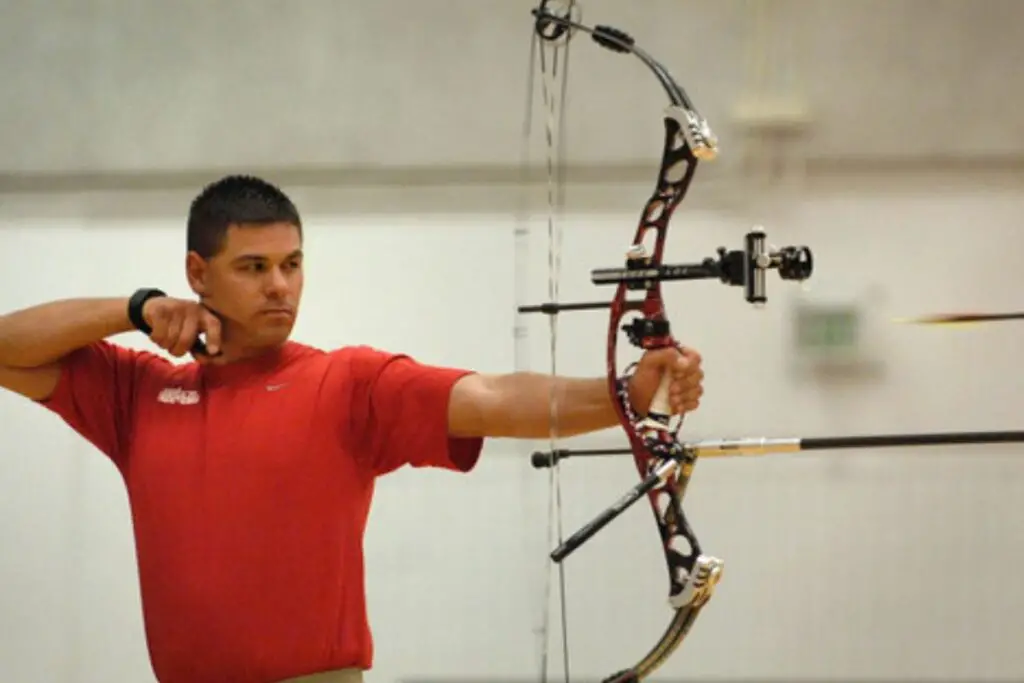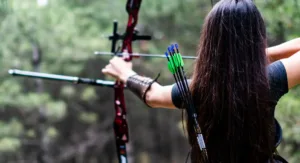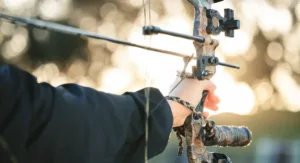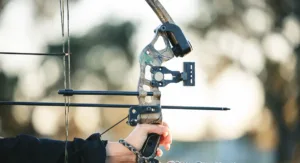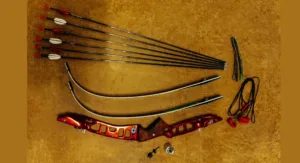Have you ever wondered how archers hit their targets so precisely? The secret lies in mastering the compound bow. Whether you’re a budding archer or a seasoned outdoor enthusiast, learning how to shoot a compound bow can elevate your skills and deepen your appreciation for the sport.
This guide is designed to help you understand the ins and outs of compound bow shooting, from the basics to advanced techniques. This will ensure you become an accurate and confident archer.
Understanding The Basics
What Is A Compound Bow?
The compound bow is a marvel of modern archery technology. Unlike traditional bows, the compound bow uses a system of pulleys and cables to bend the limbs, making it easier to hold at full draw. This mechanical advantage allows archers to aim with increased accuracy and shoot arrows with increased speed and power.
Designed for precision, the compound bow is popular with hunters and sport shooters alike. It offers a level of consistency and control unparalleled by other types of bow, which explains its popularity in competitive archery.
Key Components Of A Compound Bow
To fully grasp how to shoot a compound bow, it’s essential to understand its components. The riser serves as the central part of the bow, where you grip it. Attached to the riser are the limbs, which are connected by cams—these are the pulleys that create the compound effect.
The bowstring connects these elements, providing tension and power. Additionally, accessories such as sights, stabilizers, and arrow rests can further enhance performance. A diagram illustrating these parts can be invaluable for visual learners, helping them familiarize themselves with each component’s function.
Also Read : Master The Art Of Compound Bows – Comprehensive Guide
Getting Ready To Shoot.
Choosing The Right Bow And Equipment
Selecting the right bow is crucial to success. Consider factors like bow size, draw weight, and your personal strength and experience level. A bow that’s too heavy or too large can hinder your progress.
When choosing arrows, choose those that match your bow’s specifications. Accessories like stabilizers reduce vibrations, while sights aid in aiming. Consulting with an expert or visiting a local archery shop can provide tailored advice, ensuring your setup is optimal for your needs.
Proper Stance And Grip
Mastering the proper archery stance and grip is foundational for consistent shooting. Begin by standing with your feet shoulder-width apart, perpendicular to the target. Your non-dominant foot should be slightly ahead of the other.
Grip the bow lightly, ensuring your knuckles are 45 degrees. Maintain relaxed shoulders and straight posture. This stance provides stability, while a proper grip prevents unnecessary torque, enhancing accuracy.
Nocking The Arrow
Nocking the arrow might seem straightforward, but precision is key. Begin by placing the arrow on the arrow rest and attaching the nock to the bowstring, just below the nocking point. Make sure that the odd-colored fletching faces away from the bow.
This alignment is crucial for a smooth release, preventing the arrow from veering off course. Practicing this step repeatedly will build muscle memory, making it second nature.
Drawing The Bow
Drawing the bow smoothly is an art in itself. Start by lifting the bow towards the target, using your back muscles rather than your arms. Pull the string back until it reaches your anchor point, typically near the corner of your mouth or chin. Consistency in finding this anchor point is crucial for reliable aim. Take your time to perfect this motion, as rushing can lead to inaccuracies.
Aiming With Accuracy.
Aiming with a compound bow involves more than pointing at the target. Utilize the peep sight and align it with the front sight pin and the target. It’s like looking through a tunnel, ensuring all elements are in line. Focus on the target, not the pin, and maintain a steady hand. Practice is key to developing this skill, and over time, you’ll notice improvements in your aim and confidence.
Also Read : Mastering The Art Of Stringing A Compound Bow
Shooting With The Bow
The Release.
Releasing the arrow is a pivotal moment in shooting. A smooth release ensures the arrow travels true to its intended path. Use either a mechanical release aid or your fingers, ensuring gentle motion. Jerking the string can make the arrow miss its mark. Practicing this step with deliberate focus can drastically improve your accuracy, making you a more reliable archer.
Follow Through
Follow-through is often overlooked but vital for consistency. After releasing the arrow, maintain your stance and position until the arrow hits the target. This discipline prevents premature movements that alter the arrow’s trajectory. Think of it as a golfer’s swing; consistency and control lead to better results.
Also Read : Master Your Archery Game With A Deep Understanding Of Bow Parts
Advanced Techniques
Improve Accuracy Over Time
Once you’ve mastered the basics, it’s time to refine your skills. Implementing archery practice drills can improve your accuracy. Focus on shooting groups, where multiple arrows land close to each other. Increase the difficulty gradually, practicing at varying distances and conditions. This structured approach fosters improvement and builds confidence, making you a more competent archer.
Common Mistakes And How To Avoid Them
Archers face challenges, but recognizing common mistakes can accelerate learning. Many beginners struggle with inconsistent anchor points or an improper grip. Recognizing these issues early and seeking guidance from experienced archers or coaches can set you on the right path. Remember, every mistake is a learning opportunity.
Consistency Is The Key.
Consistency is the hallmark of skilled archers. From stance to release, each step should be repeatable and reliable. Maintaining a shooting journal can help track progress and identify areas for improvement. Celebrate small victories and remain patient; mastery takes time and dedication.
Also Read : Mastering Archery Safety: Understanding Dry Firing A Bow
Practical Tips For Different Environments
Shooting In Different Weather Conditions
Weather can impact your shooting, but with preparation, you can adapt. In windy conditions, aim slightly into the wind to counteract its force. Rain requires waterproof gear and may require you to adjust your grip. Practicing in various conditions prepares you for real-world scenarios, ensuring you’re always ready to hit your target.
Shooting From Different Positions
Archery isn’t always static. Practicing shooting from a tree stand or while kneeling can diversify your skills. Each position presents unique challenges, requiring adjustments in stance and aim. By incorporating these variations into your practice, you’ll become a versatile archer, ready for any situation.
Also Read : How to Measure Draw Length of a Bow – Archery Guide
Real-Life Examples And Case Studies
Lessons From Professional Archers
Professional archers offer a wealth of knowledge. Olympic archer Brady Ellison emphasizes consistency and practice. He advises beginners to focus on building healthy habits from the start. Learning from the experts can provide valuable insights and motivate you to strive for excellence.
Case Study: How A Beginner Improved Their Shooting Accuracy
Consider the story of Sarah, a novice archer who struggled with consistency. Through dedicated practice and expert guidance, she honed her skills, eventually competing in local tournaments. Her story illustrates the impact of perseverance and the right techniques, encouraging others to follow in her footsteps.
Also Read : Mastering Bow Tuning For Peak Archery Performance
Conclusion
Mastering the art of shooting a compound bow, you’ve embarked on a rewarding and challenging journey. By understanding the basics, refining your skills, and learning from experts, you’re well on your way to archery proficiency. Remember, practice is paramount, and with dedication, your accuracy will improve. For further resources and community support, consider joining archery clubs or subscribing to archery-focused blogs. Your next great shot is just around the corner.
Frequently Asked Questions (FAQs)
What Is The Proper Way To Shoot A Compound Bow?
The proper way involves a consistent stance, grip, draw, aim, release, and follow-through. Each step should be practiced until it becomes second nature.
How Do You Aim A Compound Bow For Beginners?
Beginners should align the peep sight with the front sight pin and target, focusing on the target rather than the pin itself. This is for better accuracy.
What Are The Common Mistakes To Avoid When Shooting A Compound Bow?
Common mistakes include inconsistent anchor points, improper grips, and jerky releases. Awareness and practice can help overcome these challenges.
How Can I Improve My Accuracy With A Compound Bow?
Regular practice, structured drills, and focusing on consistency across all shooting aspects can significantly enhance accuracy.
What Type Of Arrow Should I Use With A Compound Bow?
Choose arrows that match your bow’s specifications, considering factors like draw weight and arrow length for optimal performance.
Is It Necessary To Use A Release Aid For Shooting A Compound Bow?
While not mandatory, a release aid can enhance accuracy and consistency, making it a popular choice among archers.
Recommended Articles
- The Ultimate Guide To Choosing Between Compound Bow vs Crossbow
- How To Carry A Bow – Tips & Techniques For Archers
- Ultimate Guide To Installing Compound Bow Arrow Rest
- The Ultimate Guide To The Best Archery Brands Of Compound Bows
- How To Utilize Recurve Bow Sights: A Comprehensive Guide
- The Archer’s Craft: Understanding Parts Of Recurve Bow

